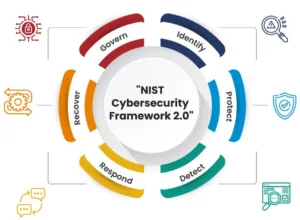
Table of Contents
Definition and Concept of Cyber Security Maturity Assessment
Definition: Cybersecurity maturity assessment is a systematic evaluation of an organization’s current cybersecurity capabilities, practices, and processes to determine its level of maturity in safeguarding against cyber threats.
Objectives: The primary objectives of a cybersecurity maturity assessment are to identify vulnerabilities, evaluate risk management strategies, assess compliance with industry regulations, optimize resource allocation, enhance incident response preparedness, and foster continuous improvement.
Importance of Cyber Security Maturity Assessment
In today’s digital age, where cyber threats are rampant and evolving, organizations must prioritize cybersecurity to safeguard their sensitive data, maintain business continuity, and protect their reputation. One crucial aspect of this is conducting a cybersecurity maturity assessment. By evaluating their current security posture and identifying areas for improvement, organizations can fortify their digital defenses, enhance risk management strategies, and ensure compliance with industry regulations.
In this blog post, we will delve into the significance of cyber security maturity assessment and its various benefits.
1. Identifying Vulnerabilities:
Cybersecurity maturity assessment provides organizations with a comprehensive understanding of their vulnerabilities. By examining existing security measures, systems, and processes, organizations can identify potential entry points for cyber threats. This enables them to take proactive steps to mitigate risks and strengthen their overall security posture.
2. Proactive Risk Management:
An effective cybersecurity maturity assessment enables organizations to proactively manage risks. By evaluating the effectiveness of current risk management strategies, organizations can identify gaps and areas that require improvement. Armed with this knowledge, they can implement appropriate measures to mitigate potential risks and minimize the likelihood and impact of cyber incidents.
3. Compliance and Regulatory Requirements:
Compliance with industry-specific regulations and standards is vital for organizations operating in various sectors. Cybersecurity maturity assessment assists organizations in meeting these compliance requirements. By evaluating their security practices against established frameworks and guidelines, organizations can ensure adherence to cybersecurity best practices and demonstrate their commitment to data protection.
4. Prioritizing Resource Allocation:
Resource allocation is a critical consideration for organizations, especially when it comes to cybersecurity. A cybersecurity maturity assessment helps organizations understand their resource needs by highlighting areas that require immediate attention. By focusing investments on critical security domains, organizations can optimize their budget and allocate resources effectively to enhance their cybersecurity posture.
5. Enhancing Incident Response Preparedness:
An integral part of cybersecurity maturity assessment involves evaluating an organization’s incident response capabilities. By identifying gaps in incident response procedures and protocols, organizations can enhance their preparedness to effectively respond to cyber incidents. This enables them to minimize the impact of security breaches, mitigate potential damage, and facilitate swift recovery.
6. Building Stakeholder Trust:
In an era where data breaches can have severe consequences on an organization’s reputation, building stakeholder trust is paramount. A robust cybersecurity maturity assessment helps organizations demonstrate their commitment to cybersecurity to customers, partners, and stakeholders. By prioritizing cybersecurity and actively working towards improving their maturity levels, organizations enhance their brand reputation and inspire trust among stakeholders.
7. Continuous Improvement and Adaptation: Cyber threats and technology landscapes are constantly evolving. Cybersecurity maturity assessment fosters a culture of continuous improvement within organizations. By regularly assessing maturity levels, tracking progress, and adapting strategies, organizations can stay ahead of emerging threats, remain resilient, and ensure their security measures align with evolving industry standards.
Key Components of Cyber Security Maturity Assessment
1. Policies and Procedures: Evaluating the existence, effectiveness, and enforcement of cybersecurity policies, standards, and procedures within the organization.
2. Security Controls: Assessing the implementation and effectiveness of technical and administrative controls in protecting critical assets and sensitive information.
3. Risk Management: Evaluating the organization’s risk management framework, including risk identification, assessment, mitigation, and monitoring practices.
4. Incident Response: Assessing the organization’s incident response capabilities, including the presence of an incident response plan, incident handling procedures, and training for personnel.
5. Compliance: Evaluating the organization’s compliance with relevant laws, regulations, and industry-specific cybersecurity frameworks.6. Governance and Leadership: Assessing the level of cybersecurity governance, executive leadership involvement, and the establishment of a cybersecurity culture within the organization.
The Concept of Cyber Security Maturity Levels
Maturity Levels: Cybersecurity maturity assessments often categorize organizations into maturity levels or stages, such as initial, defined, managed, measurable, and optimizing. These levels represent the organization’s current state of cybersecurity maturity and serve as a roadmap for improvement.
Progression and Continuous Improvement: The goal of a cybersecurity maturity assessment is to help organizations progress from lower maturity levels to higher ones. This progression involves continuous improvement in security practices, the implementation of appropriate controls, and the adoption of best practices.
Key Benefits of Cyber Security Maturity Assessment
1. Vulnerability Identification: A maturity assessment helps identify vulnerabilities, weaknesses, and gaps in an organization’s cybersecurity posture, enabling proactive measures to strengthen security defenses.
2. Risk Management Enhancement: By evaluating risk management strategies, organizations can identify areas for improvement, implement effective risk mitigation measures, and prioritize resource allocation.
3. Compliance and Regulatory Alignment: A maturity assessment helps organizations ensure compliance with relevant laws, regulations, and industry-specific frameworks, reducing legal and financial risks.
4. Incident Response Readiness: Assessing incident response capabilities allows organizations to enhance their preparedness for cyber incidents, minimizing the impact and facilitating timely and effective responses.
5. Continuous Improvement: Cybersecurity maturity assessment promotes a culture of continuous improvement by providing organizations with insights into their current state and enabling them to adapt to evolving threats and technologies.
Key implementation steps of Cyber Security Maturity Assessment
Step 1: Preparing for the Assessment
A. Defining the scope and objectives of the assessment
B. Identifying the assessment criteria and frameworks
C. Gathering necessary resources and information
Step 2: Assessing Current State
A. Evaluating the existing cyber security policies and procedures
B. Analyzing the effectiveness of security controls and measures
C. Identifying vulnerabilities and potential risks
Step 3: Identifying Gaps and Prioritizing Improvements
A. Comparing the current state with desired maturity levels
B. Pinpointing areas of improvement and vulnerabilities
C. Prioritizing actions based on risks and criticality
Step 4: Developing a Roadmap for Enhancement
A. Defining the target maturity levels for each domain
B. Establishing goals, milestones, and timelines
C. Allocating resources and budget for implementation
Step 5: Implementing Enhancements
A. Executing necessary changes and improvements
B. Integrating security measures and controls
C. Monitoring progress and adjusting as needed
Step 6: Continuous Monitoring and Evaluation
A. Establishing a monitoring and evaluation framework
B. Conducting periodic assessments and audits
C. Reviewing and updating the maturity roadmap as needed
Conclusion
In an increasingly interconnected and threat-prone digital world, cybersecurity maturity assessment plays a pivotal role in an organization’s defense strategy. By identifying vulnerabilities, enabling proactive risk management, ensuring compliance, optimizing resource allocation, enhancing incident response preparedness, building stakeholder trust, and fostering continuous improvement, organizations can fortify their digital defenses and stay resilient against cyber threats.
Prioritizing cybersecurity maturity assessment is essential for safeguarding sensitive data, maintaining business continuity, and preserving an organization’s reputation in the face of ever-evolving cyber risks.
Do follow on “https://cybertechworld.co.in” for more such insightful cybersecurity content.



















